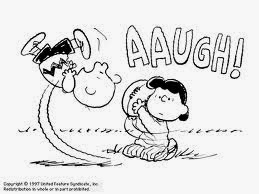 |
| Bill Watterson's Calvin and Hobbes |
Below is a closer look at the course comics and graphic novels have taken in and out of the classrooms But, before we look at the course of comics, here are some resources explaining why graphic novels fit in most classrooms, along with suggested reading lists and teaching suggestions:
 GREAT RESOURCES:
GREAT RESOURCES:- How to read graphic novels
- How graphic novels promote critical thinking
- The best of kids' graphic novels in 2013
- The best kids' graphic novels of 2012
- The best kids' graphic novels of 2011
- Teaching suggestions for Boxers and Saints by Gene Yang
- Teaching suggestions for Smile by Raina Telgemeir
- Great graphic and prose novels for studying Black History Month
THE COURSE OF COMICS IN THE CLASSROOM:
 Early comic books (detective/crime stories) were sold primarily at newsstands to a predominantly male market. In the 1950’s, New York psychiatrist, Fredric Wertham went before Congress after publishing “Seduction of the Innocent,” blaming comics for an array of crimes from truancy to homosexuality and murder. In response to growing social concerns, publishers began offering more “acceptable” comics, the Comics Code Authority (authorizing the comics' content compliance) was instituted.
Early comic books (detective/crime stories) were sold primarily at newsstands to a predominantly male market. In the 1950’s, New York psychiatrist, Fredric Wertham went before Congress after publishing “Seduction of the Innocent,” blaming comics for an array of crimes from truancy to homosexuality and murder. In response to growing social concerns, publishers began offering more “acceptable” comics, the Comics Code Authority (authorizing the comics' content compliance) was instituted.Comic books went ‘underground’ at that point, and were sold in small comic book shops. In fact, they are still predominantly sold there (although there's a growing surge of online and standard bookstore sales as well). Classroom use/incorporation of comics, at this point, was not on the radar. Nor were there any graphic novels. There was the stigma that "comics =violence" and in truth, the quality and choice of content - especially for kids - was quite limited.
In the last decade, the Comics Code Authority was rendered defunct, and with Art Spiegelman's Maus came the idea of bound books using squential art for storytelling - or graphic novels. Furthermore research by Carol Tiley, a University of Illinois professor of Library Science has very recently questioned the veracity of Wertham's contentions finding that “the doctor revised children’s ages, distorted their quotes, omitted other causal factors and in general ‘played fast and loose with the data he gathered on comics."
The disbanding of the Comics Code Authority, the demand from teachers and librarians for reading choices, the exploding amount of quality fiction and nonfiction graphic novels, the explosion of computer and graphic technologies (making it easier and cheaper to produce), the ease of self-publishing, and even the Common Core Standards call for multiple reading and literacy formats, are all working to empower new and varied choices in classroom texts for the next generation of learners, academics, thinkers and entrepreneurs.
The thing is, comics, or the concept of sequential storytelling through pictures and/or words has been around A LONG time.
HISTORY OF VISUAL COMMUNICATION
 |
| Cave of Altamira, near Santander, Spain |
Large, wild animals occupy the most common cave painting themes. Some believe these paintings were used as magic rituals, meant to increase the numbers of animals killed. Others posit that they were means of communicating with others and/or carried religious or ceremonial purposes.
 |
| http://en.wikipedia.org/wiki/Egyptian_hieroglyphs |
Regardless of their inherent purpose, these images were a means of visual communication across communities.
Egyptian hieroglyphs is another example of the early use of images to communicate. These images (see the example here of a section of the Papyrus of Ani), a formal writing system developed by the ancient Egyptians, codify images into repeatable and reproducable symbols. These images and examples of "proto-writing" were the precursors of early alphabets (Egyptian Canaanite, Chinese, Phoenician).
 |
| Rome's Trajan Column at wikipedia |
Tapestries, codices, and many, many more examples are additional means we've used to visually and sequentially tell our stories throughout history. And so, today, visual storytelling is revisited through graphic novels, social media, infographics, and more.
Shortly after that Spiegelman’s “Maus: A Survivor’s Tale” came out and received a Pulitzer Prize in 1992. With these developments, comics and graphic novels appeared on mass-market radars and today the plethora of topics for kids and young adults is just booming! Librarians are solidly ‘on-board’ and teachers are quickly following.
Here is a Scott McCloud TED Talk that is as entertaining as it is informative and creative. It provides an outstanding account of the art, the history, and future of sequential art storytelling.
Changes in educational attitudes towards graphic novels began in the 1980’s as well, as educators realized there were all kinds of minds (and intelligences) in the classroom and graphic novels empowered the weaker language learners and reluctant readers. The 1990’s marked a growing awareness and need for teaching verbal AND visual literacies. To empower 21st century literacy learners educators must now embrace teaching reading with print-text and visual-text. Also, a younger generation of comic and graphic novel readers are now teachers and parents themselves.
It will be interesting to watch how the art of storytelling continues to develop. See the TED talk above by Scott McCloud for a fascinating look at where he thinks it will go!
It will be interesting to watch how the art of storytelling continues to develop. See the TED talk above by Scott McCloud for a fascinating look at where he thinks it will go!
In the meantime, thank you for your visit and please leave your reactions and opinions in the comments below.
 |
| Charles Schulz's Peanuts |
I'm happy that comics in all forms are making inroads into the classroom now. When I was a child, I enjoyed the Archie & Betty and Veronica comics, Little Lulu, and others.
ReplyDeleteleslie
abcw team
I need to link to this...
ReplyDeleteThanks!!!
DeleteLovely, detailed post on the effect of comics & graphic novels !
ReplyDeleteI would allow comic books in the house when the children were young - so they went elsewhere and read them! I have gradually come to the conclusion that the have their place....
ReplyDeleteOh dear, I meant to say I would NOT allow comic books in the house.....
ReplyDeleteI happen to like some comic books. I like Dave McKean's work. It's twisted, dark, yet has a whole lot of thought in it.
ReplyDeleteI grew up loving comic books like Little Lulu and Disney stories.
ReplyDeleteAs I grew i was engrossed in Junior Classics and read things like The Prince and the Pauper. It gave me the first taste of history and the solid classics.
I experienced a little back in grade school where comic readings were not approved by teachers and I remember boys hiding their Superman comics. Great post.
ReplyDeleteYour post brought back memories. We weren't allowed comics in school and so they became such a treasured thing for all of us!!
ReplyDeleteI adore comic books, growing up reading tons of them, and I always supported my son to read them as well, since he was little. It's a marvelous way to learn about right and wrong, to see the many sides of a situation, and to simply have fun! Great post. :)
ReplyDeleteAs a kid, I remember getting the classics in comic book format. As a former teacher, I believe reading (in all forms) is important. Tastes change over time, including comic books in school isn't a bad thing if you ask me. - Margy
ReplyDeleteHi there,
ReplyDeletePlease get with me if you could. I operate a family-friendly and fairly educational comic book and popular arts convention in Grand Rapids, Michigan, and I would like to investigate the possibility of Dr. Jaffe being a guest at our show and doing a presentation. Thank you.
Mark Hodges
Grand Rapids Comic-Con
616-281-5930
grcomiccon@gmail.com
www.grcomiccon.com
that's great, as a homeschool mom I think you have to reach out to children using their interests.
ReplyDeleteThis comment has been removed by the author.
ReplyDeleteThis comment has been removed by the author.
ReplyDelete